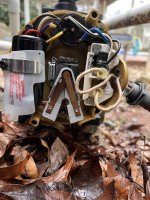- May 13, 2021
- 25
- Pool Size
- 39000
- Surface
- Vinyl
- Chlorine
- Salt Water Generator
- SWG Type
- Autopilot Digital PPC3 (RC-42)
I opened the pool today and the pump just hums for 5 seconds and then trips the breaker. After searching for awhile I noticed that it might be corroded and a simple turn could maybe fix it to break it free. All the videos I see all have access to their impeller and can turn with a screwdriver, but I don't. Any tips?



